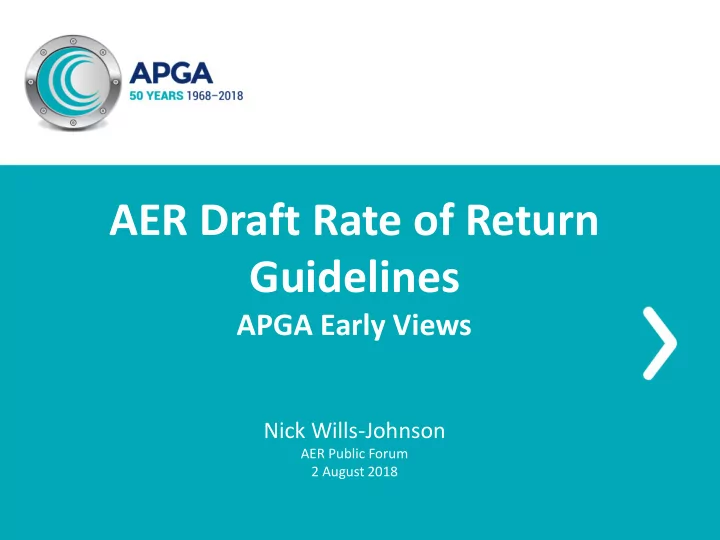

AER Draft Rate of Return Guidelines APGA Early Views Nick Wills-Johnson AER Public Forum 2 August 2018
Things we accept – 60% + of Draft Guidelines • Cost of debt, despite… • Gearing – roughly in-line with gas businesses (ES Table 14, p.164)
Things we don’t understand - 1 • “Not all experts were (fully) available over the course of preparing the expert joint report to present their views … .. ” • Three times in report, on beta and MRP. • Symptomatic of wider problems with respect of use of expert sessions • Whither the Black CAPM? • “No change in role. However, at this time we have diminished confidence in the robustness of the Black CAPM and are … not persuaded to select an equity beta towards the top of the observed empirical estimates” (ES p.178) • “We have considered the Black CAPM and low beta bias. Our view is to not use the (theory of the) Black CAPM or the low beta bias when selecting our point estimate” (ES p.301) • Theory of the Black CAPM used in 2013, no change in theory since then. Debate has been about empirical validity of zero beta premium and use.
Things we don’t understand - 2 • Whither the DGM – wide dividend growth rates? • 2013 – 3.78 to 5.1%, now 1 to 5.5%, but lower bound appears due to Fenebris and AER’s expert said: • “ It was noted in the submission from the ENA that Fenebris' growth rate can lead to results that seem implausible, and advice from Partington and Satchell agreed with that. The advice from Partington and Satchell also stated that whilst the general trend of the CGS rates may follow the GDP growth it has the potential to be a poor predictor when the risk free rate is particularly high or low. ” (ES p219) Green brackets are the historical MRP range
Things we don’t understand - 2 • Whither the DGM – other issues? Issue question “The thrust of the argument is actually that if you want to know what rate of return investors are thinking Analyst forecasts about and acting on then look at surveys. That's the thrust of his argument. His argument is because behaviour follows. If you look at funds flows they follow the surveys”. Session 2, unproofed transcript p89) CAPM biased against actual returns; ignore bias. Analyst forecasts biased against actual outcomes; ignore Analyst forecasts DGM Robust year long study by AER to get best estimate. Inflation Unsure – Lally says “maybe” (ES p220) Term structure of equity “Frontier, in its 2018 report to the AER, submit that because the RBA data shows earnings forecasts have not Sticky dividends fallen as much as expected in recent years that Sticky Dividend concerns should not be considered. Whilst this concern may not be an issue at the current time” (ES, p220) See over Stable return on equity Unsure Dividend reinvestment ES p209-215 on historical MRP – where is assessment of its flaws?
Things we don’t understand - 3 • Whither the Wright CAPM? • “… we consider there is neither strong theoretical reasons, nor strong empirical evidence, to support an ongoing and consistent inverse relationship between the MRP and the risk free rate. We also note the evidence since 2013 has increased our concerns about relying on the Wright approach” (ES p.235) • “We analysed the historical results from our construction of the DGM and found that there is as much as an 80 per cent negative correlation between the MRP estimates from the DGM and the risk free rate. This means the DGM implicitly (in its application) assumes a stable return on equity. This raises two concerns for us … … Firstly, this is inconsistent with our view that there is a lack of support for an inverse relationship between the risk free rate and the MRP. This was discussed at length in the second concurrent evidence session, and is covered in more detail in 0 (sic). ” (ES p.221) • Note: not necessarily arguing for adoption of Wright CAPM, just confused as to why it was dropped
Things we don’t understand - 4 AER Wright Wright beta est CAPM CAPM 10.1% 12.6% 0.4 5.6 6.6 0.6 7.1 8.6 0.8 8.6 10.6 Adapted from Table 21 – AER RoE = 6.24% “We recognise the equity risk premium ranges from the Wright approach, valuers' and other regulators’ decisions are above the ERP we have estimated. By contrast, our ERP for this decision represents an increase in comparison to the DRP. Once their strengths and weaknesses of the available cross checks are considered, we do not see a case for making further adjustment to the result calculated using the SLCAPM. “ (p189)
Things we don’t understand - 4 Times during the past five years when ERP- DRP<171 bps – roughly 6 months out of 60
Concerns about electricity v gas - experts • Unsure about interpretation of expert views • We think experts concluded there might be a difference in principle, but quantifying it difficult • We agree – but don’t see that this leads to no difference
Concerns about electricity v gas - evidence • Discussion on NZCC findings, but not APGA econometric work (ES p.104) • AER ignores in Draft Guidelines that gas transmission is price capped (ES p.102) • Many US gas companies are Asset beta revenue capped • This is new evidence, not considered in 2013 (ES p.102) • AER suggests risk can be • We think this is suggestive of a different beta for gas & addressed via depreciation; (ES electricity. In US, vertical integration (ES p.104) happens p.103) but it isn’t in both gas & electricity, so not a reason to reject • evidence. APA tried 3 times; AER said no • Subject for further consultation? • Credit rating differences not considered
Recommend
More recommend